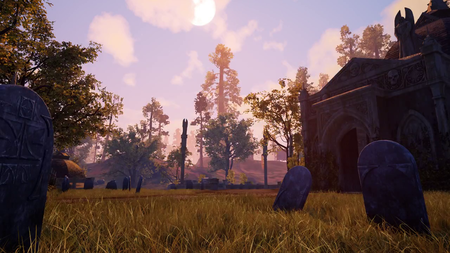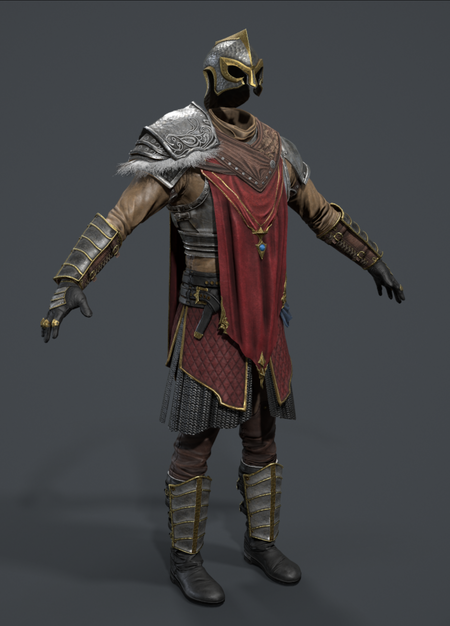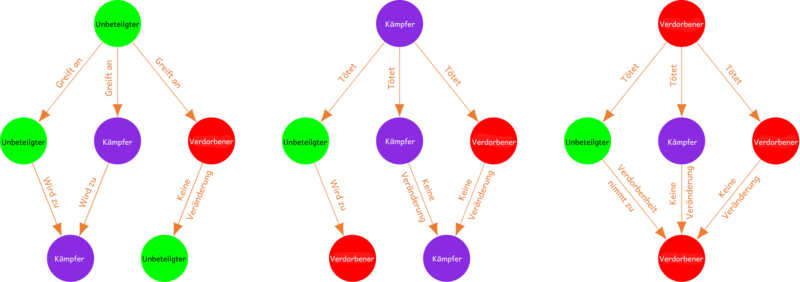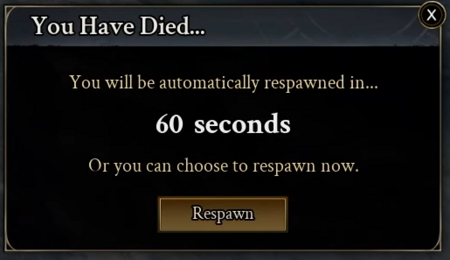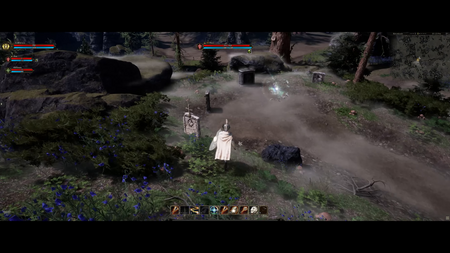Spieler Verderbnis
When you gain that corruption you have the potential of losing your completed items, your weapon, your armor, stuff that is very difficult to achieve; and then the other aspect of that is, that in order to deter basically players taking alternate characters and saying this is my PK alt, the more players you kill, the more corruption you gain, the higher your combat efficacy in PVP diminishes. If you're out there and you killed 20 players... you will not be able to perform in PVP any longer. You will need to take that character and go work off that corruption. The other aspect of corruption is that if you kill another player, who is a non-combatant and the level disparity between you and that player is great, you will gain a higher amount of corruption from that single kill. To the point where you should not be killing a level one character.[1] – Steven Sharif
Wenn ein Kampfteilnehmer (violett) einen Nicht-Kampfteilnehmer (grün) in PvP tötet, wird er als verdorben markiert (rot).[2]
- Die Verderbnispunkte eines Spielers nehmen mit jeder Tötung eines Nicht-Kampfteilnehmers zu.[3][4]
- Je grösser der Levelunterschied der Spieler, desto mehr Verderbnispunkte werden verteilt.[3][4]
- Verderbnisstrafen tauchen auf, sowie die Anzahl an Verderbnispunkte eines Spielers zunimmt.[5] Je mehr Verderbnispunkte:
- Desto mehr werden Fähigkeiten und Statuspunkte gehemmt. (Weniger Lebenspunkte und Mana, niedrigere Fähigkeit im Umgang mit Ausrüstungsgegenständen), bis der verdorbene Spieler schliesslich nicht mehr effektiv kämpfen kann.[6] Diese Hemmungseffekte beeinträchtigen nur PvP-Kämpfe.[7]
- Desto höher die Chance darauf, getragene Ressourcen und Ausrüstungsgegenstände ( Waffen und Rüstung) fallenzulassen, wenn der verdorbene Spieler stirbt.[3][6][8]
- Verderbnis hat einen sichtbaren Effekt auf das Aussehen eines Spielers.[9]
- Wenn ein Nicht-Kampfteilnehmer einen verdorbenen Spieler angreift, wird er nicht als Kampfteilnehmer markiert.[10]
- Der Aufenthaltsort eines verdorbenen Spielers wird Kopfgeldjägern auf ihrer Weltkarte preisgegeben.[3][2]
- Verdorbene Spieler können Kopfgeldjäger töten, ohne zusätzliche Verderbnispunkte zu erhalten.[11][12]
- Verderbnisstrafen werden im Kampf gegen Kopfgeldjäger negiert.[11]
The more corruption you gain, the less effective you become in PvP and there's going to be a certain period at which point you have gained enough corruption that you're going to be gearless and you're also going to have a massive reduction in your PvP efficacy.[13] – Steven Sharif
Reward without risk is meaningless... Corruption is just another word for risk.[14] – Steven Sharif
You can't necessarily time perfectly the damage or understand even the health of the player. Unless you were in their party you cannot see an opponent's health as well, so that's another component that adds risk..[15] – Steven Sharif
Verderbnis entfernen
Das Hauptheilmittel für Spieler Verderbnis ist der Tod. Es ist möglich, dass das vollständige Entfernen der Verderbnis mehrere Tode benötigt.[17][10]
- Erfahrungspunkte reduzieren die Verderbnispunkte eines Spielers auch langsam.[17]
- Dies führt zu einer lustigen Erfahrung für Kopfgeldjäger, während sie dich versuchen zu fangen während du die Verderbnis abarbeitest.[17] – Steven Sharif
- Verderbnisdauer ist in Militärknotenpunkten reduziert.[18]
Kopfgeldjäger
Spieler können sich den Titel Kopfgeldjäger durch eine Quest verdienen, welche den Bewohnern einer Militär-Node der Stufe 4 (Stadt), und unter Umständen derer Vasallen-Nodes zur Verfügung steht. [19][4]
- Kopfgeldjäger können ihre Pfadfinder-Fähigkeit einsetzen, um einen verdorbenen Spieler auf ihrer Weltkarte aufzuspühren.[20][21]
- Dies wird den Kopfgeldjäger für bis eine Stunde nach Aktivierung für PvP Kämpfe markieren, aber nur für verdorbene Spieler.[20]
- Die Pfadfinder-Fähigkeit kann ein- und ausgeschaltet werden.[20][22]
- Es ist möglich, dass in Zukunft Kopfgeldjäger gegen verdorbene Spieler, die die Pfadfinder Fähigkeit ausgeschaltet haben, permanent markiert werden. Dies wird auf Grund von Tests entschieden werden.[23]
- Die Genauigkeit von Kopfgeldjäger Karten wird von dem Fortschritt eines Spielers im Kopfgeldjägersystem bestimmt.[24]
- Verdorbene Spieler können Kopfgeldjäger töten, ohne zusätzliche Verderbnispunkte zu erhalten.[11][12]
- Kampf-Strafen von verdorbenen Spielern werden im Kampf gegen Kopfgeldjäger negiert.[11]
- Oberster Kopfgeldjäger ist ein Regierungs-Titel, welcher dem Träger Zugang zu speziellen NPCs in der Node gewährt.[25]
- Die Anerkennung für das Töten eines verdorbenen Spielers erhält der Kopfgeldjäger, der den tödlichen Treffer landet (letzter Schlag). Zukünftig wird evtl. der Schadensbeitrag ausschlaggebend sein.[26]
Kopfgeldjäger-Karten
Spieler mit genügend Verderbnispunkten sind auf der Weltkarte und auf Mini-Karten sichtbar. Diese Spieler haben eine eigene Markierung auf der Weltkarte, die von einem NPC eines Militärknotenpunktes von mindestens der Stufe 4 (Stadt),und wird nur an jene Spieler verteilt, die den Kopfgeldjäger Titel besitzen.[27] Die Genauigkeit von Kopfgeldjägerkarten wird vom Fortschritt eines Spielers im Kopfgeldjägersystem bestimmt.[24]
Tavernen sind Orte, an denen Kopfgelder ausgehängt werden. Gewinnen Spieler viele Verderbnispunkte, kann es sein, dass Tavernen ein Kopfgeld auf diese Spieler aushängen. Oder sie verlangen, dass ein spezifisches Gebiet von Problem-Spielern gereinigt wird. Dies lässt einen Indikator auf der Weltkarte erscheinen.[28]
Bounty hunter Pathfinding ability
| Skill | Icon | Primär | Base skill |
|---|---|---|---|
| Pfadfinder | Bounty hunter | Reveals corrupted player locations on the bounty hunter's map.[20][29] Activating this ability will flag the bounty hunter for combat only to corrupted players for a period of one hour from the time of activation.[20] The pathfinding ability can be toggled on or off.[20][22] |
Verdorbene Spieler töten Kopfgeldjäger
Verdorbene Spieler können beim Töten von Kopfgeldjägern Belohnungen erhalten.[30]
NPC-Wachen
NPC-Wachen werden verdorbene Spieler bei Sichtkontakt töten.[32]
PvP-Statuseffekte
Das Open-World PvP Flagging-System soll Spieler davon abhalten, anderen Spielern den Spielspaß zu verderben (Griefing).[2]
- Spieler haben die Möglichkeit, am Open-World PvP teilzunehmen, ohne zu morden (siehe Schlachtfelder).[33]
- Spieler werden andere Spieler wiederholt töten (ganken), jedoch soll Ashes of Creation keine "Gank-Box" sein.
- Die Strafen für das Töten von anderen Spielern sollen streng genug sein, um Spawn-Camping zu unterbinden.[34]
- Beschwörungen verwenden das gleiche Flagging-System und teilen den Flagging-Status des Spielers.[35][36]
Das Open-World PvP Flagging-System in Ashes of Creation ist in drei Stufen unterteilt.[4]
- Unbeteiligte (grün)
- Alle Spieler starten als Unbeteiligte.[10]
- Nicht-erzwungene Angriffe (zum Beispiel AoE) treffen keine Unbeteiligten.[37]
- Unbeteiligte, welche von Mobs getötet werden (der Mob setzt den tödlichen letzten Treffer), beeinflussen nicht den Flagging-Status des angreifenden Spielers. Da jedoch die exakte Gesundheit eines Spielers für andere Spieler nicht sichtbar ist (außer sie befinden sich in der selben Gruppe, Raid, Allianz, oder Gilde), besteht für den Angreifer das Risiko, den Spieler ungewollt zu töten und so verdorben zu werden.[38]
- Das Plündern von Spieler-Leichen beeinflusst den Flagging-Status nicht.[39]
It's important to note that the idea is going to be that, unless a player is in your party, alliance, guild, or raid that you will not have definitive knowledge of their exact hit point values. So when you do something that's sketchy like that, where you want to bring them close to death and let a monster finish him off, you are taking the risk of overhitting and actually gaining the corruption.[38] – Steven Sharif
- Kämpfer (lila)
- Spieler werden als Kämpfer markiert, wenn sie oder ihre Beschwörung andere nicht-verdorbene Spieler mit einer erzwungenen Attacke angreifen. Sollte der angegriffene Spieler zurückschlagen, wird er ebenfalls als Kämpfer markiert, anderenfalls bleibt er ein Unbeteiligter.[35][40][10]
- Unbeteiligte, welche ein Open-World Schlachtfeld (PvP-Event) betreten, werden automatisch als Kämpfer markiert und behalten diesen Status auch nach dem Verlassen des Schlachtfelds für eine gewisse Zeit bei.[4]
- Dies betrifft auch Angriffe von Kampfbegleitern (oder andere von Spielern kontrollierten Wesen).[41]
- Unbeteiligte, welche andere Kämpfer oder Verdorbene heilen, verstärken, oder anderweitig mit ihnen (positiv) interagieren, werden als Kämpfer markiert.[42][43]
- Spieler können Kämpfer ohne Konsequenzen töten, und werden dazu auch ermutigt, da Kämpfer geringere Bestrafungen für den Tod haben.[10]
- Spieler können ihren Flagging-Status nicht manuell zu "Kämpfer" setzen.[40]
- Nach der letzten Attacke auf einen Unbeteiligten oder anderen Kämpfer bleiben Spieler für 90 Sekunden als Kämpfer markiert.[44]
- Spieler können sich nicht aus dem Spiel abmelden, solange sie als Kämpfer markiert sind.[45]
- Verdorbene (rot)
- Wenn ein Spieler, oder seine Beschwörung, einen Unbeteiligten tötet, wird er verdorben.[35][2]
- Verderbnis multipliziert die Bestrafungen für den Tod und enthüllt die Position des verdorbenen Spielers für Kopfgeldjäger.[2]
- Die Menge der angesammelten Verderbnis erhöht sich mit jedem getötetem Unbeteiligten.[4]
- Unbeteiligte, welche einen Verdorbenen angreifen, werden nicht als Kämpfer markiert.[10]
- Verdorbene Spieler können Kopfgeldjäger angreifen und töten, ohne zusätzliche Verderbnis zu erhalten.[12]
- Verdorbene Spieler haben einen 60-Sekunden-Timer, bevor sie sich aus dem Spiel abmelden können.[45]
Spieler können (über ein Kontrollkästchen) festlegen, ob ihre AoEs andere markierte Spieler treffen sollen. Ist das Kästchen aktiviert, beeinflusst Flächen-Heilung und -Schaden andere Spieler. Ist das Kästchen deaktiviert treffen AOE-Effekte keine anderen Spieler, und somit wird der ausführende Spieler nicht als Kämpfer markiert.[46]
If you have that check-box for flagging with your AOEs and heals available then you will flag. If you do not have that box checked then on completion of the skill it will not flag you because the check was made at the start that there was a flagged party member; and then he will not he or she will not receive the beneficial effect as a result or the damage, if it's an offensive spell.[46] – Steven Sharif
Spieler können keine Mitglieder aus der selben Gruppe, Raid, Gilde oder Allianz angreifen, um sich so als Kämpfer zu markieren.[47]
Belagerungen, Karawanen und Gildenkriege sind vom Flagging-System ausgenommen.[48]
You're not going to see griefing in the game very often; and that's because our flagging system. The corruption mechanics are based around disincentivizing a griefer or PKer but still offering the opportunity, should the occasion arise, where the benefits outweigh the risk, you have the ability to do so. If you gain corruption, which is killing a non-combatant - a player who is not fighting back basically - if you gain that corruption, your world has changed. It is not going to be a very beneficial place to be and you have the potential of losing your gear. Your combat efficacy decreases based on the amount of corruption you accrue. It is a comfortable balance between player agency and grief and basically removing player agency for other players.[49] – Steven Sharif
Differences from other games
Während sich Ashes of Creation von Lineage II ((und anderen Spielen)) inspirieren ließ, wurden auch mehrere Mängel bei der Umsetzung dieser Spiele behoben. [50][51][52][53] Der Ansatz des Flagging-System in Ashes of Creation besteht darin, das griefing weiter zu unterbinden und gleichzeitig dem System zu ermöglichen, das Risiko in der Open-World Umgebung relevant zu halten. [50]
In erster Linie gibt es PvP in Ashes sowohl in Opt-in-Systemen und Events als auch in unserem Open-World-Flagging-System. Und obwohl es wahr ist, dass ich Spiele wie Lineage 2 genossen und mir viel Inspiration von ihnen geholt habe, haben wir unseren Ansatz für das Flagging-System von Ashes erneuert und angepasst, um den Anreiz zum Griefing noch weiter zu verringern und gleichzeitig zu ermöglichen, dass das System in der Open-World-Umgebung risikorelevant bleibt . Die überwältigende Mehrheit der Spielererfahrungen mit PvP in Ashes wird durch einvernehmliche Systeme wie Karawanen, Belagerungen, Kriege, das offene Meer und andere Ereignisse erfolgen. Die Spieler werden die Wahl treffen, an diesen Systemen teilzunehmen oder nicht. Und wenn sie sich für die Teilnahme entscheiden, wird der Erfolg erheblich belohnt[50] – Steven Sharif
- PvP in Ashes of Creation gibt es sowohl in Opt-In Systems und Events als auch im Open-World PvP mit einem Flagging (und Korruptions-) System.[50]
In der offenen Welt, wenn es um die Knappheit von Ressourcen, Raids, Dungeons und/oder Jagdrevieren geht, wird durch unser Flaggingsystem ein wichtiges Risiko-Rendite-Element eingeführt. Spieler müssen sich ihrer Umgebung und des Rufs anderer Spieler, die sich möglicherweise in der Nähe aufhalten, bewusst sein. Das Flagging-System soll in allen Situationen immer ein Risikoelement bieten, ist aber auch so konzipiert, dass sich Griefing und PK'ing fast nie lohnen. Die Feinheiten dieses Systems sind komplex, weshalb es natürlich umfangreiche Tests und Rückmeldungen erfordert.[50] – Steven Sharif
- Der Korruptionsgewinn berücksichtigt die Stufenunterschiede zwischen dem Angreifer und dem getöteten Spieler. Je größer die Ungleichheit, desto höher ist die Korruption. [2] [5] [6] [7] [8] Korruptionsstrafen treten auf, wenn die Korruption erlangt wird. {quote|CC_effects_do_notapply_to_non-combatants.png|link=https://youtu.be/Cvuj0DceOHI}}[54][3][55][4] Korruptionsstrafen treten auf, wenn die Korruption erlangt wird. [5]
Das sind alles Dinge, die ich im System geändert habe, um einige dieser Lücken zu schließen. Natürlich können und wollen wir, wie gesagt, die Möglichkeit, dass dieses Risiko besteht – damit es realisiert wird – nicht zu 100 % aufheben. Wir möchten jedoch sicherstellen, dass diese Gelegenheiten selten und selten sind und nicht den Großteil des Spielerlebnisses ausmachen, sagen wir in der offenen Welt. Und das tun wir, indem wir all diese Risiken und Kosten in die Entscheidung einbeziehen, Korruption zu erlangen und dann einen anderen Spieler in der offenen Welt zu töten. Es wird einfach nicht oft gemacht und das ist meine Erwartung und Meinung. Das Ziel des Systems besteht auch darin, zu verhindern, dass Trauer eine praktikable Option oder Spielweise ist. Und als Ergebnis dieses Wunsches für das System werden wir es durch Tests so verfeinern, dass dieses Ergebnis erreicht wird. Und das ist die Absicht und der Zweck des Designs.[56] – Steven Sharif
- Eine Erhöhung des Verderbnis-Scores sorgt für eine zunehmende Fähigkeitsdämpfung im PvP Kampf.[51][52][53][54][3][4]
- Die Beseitigung der Verderbniss durch XP-Grinding dauert deutlich länger als bei Lineage II.[51]
- Es gibt auch ein Kopfgeldsystem , das die Standorte korrupter Spieler auf der Karte aufdeckt. [51][52][17][10]
- Fähigkeiten mit CC Effecten gelten nicht für Non-Combatants. Dies verhindert, dass Spieler Angriffe starten, die nicht markierte Spieler betäuben.[51]
- Spieler, die corrupte Spieler heilen, Buffen, oder auf andere Weise unterstützen, werden als Kombattanten markiert. [56][57][42][43]
- Der Corruption score hat einen skalierenden Einfluss auf Skill und Stats der sie letztendlich im PvP wirkungslos macht. [56][58][55][51][1][13][6] Diese Dämpfung betrifft nur PvP-Kämpfe.[7]
- Nichtkombattanten können korrumpierte Spieler angreifen, ohne sich selbst als Kombattanten zu kennzeichnen.[56][10]
- Es gibt einen 60-Sekunden-Timer zum Abmelden bei Verderbniss. Wenn du die Verbindung zum Client während der Abklingzeit erzwingst, verbleibt der Charakter im Spiel.[56][45]
Player death
When a player dies they disintegrate into ash. The ashes contain any items lost by the player due to applicable death penalties.[60][61][62][6][63]
- PvP-Statuseffekte is not triggered by looting.[39]
- It might even be the case that their particular bag space doesn't have available location for a three-by-one log; and you're a lumberjack and they see you just chopping down these trees and you're like, there's no point in me engaging with this person, because I have nothing to gain due to my capacity.[66] – Steven Sharif
- There will be a period of time following a player's death before their mule despawns. Other players must kill that player's mule to be able to loot it.[67]
- If the mule dies its corpse will contain the same percentage of lootable items according to the player's death penalties.[67][68]
- Players do not lose gold upon death, no matter their corruption level.[69]
- Glint looted from a dead character by any other player, regardless of affiliation, becomes stolen glint. Character's who loot their own bodies will recover their glint in its non-stolen state.[70][71][61]
Bestrafungen für den Tod
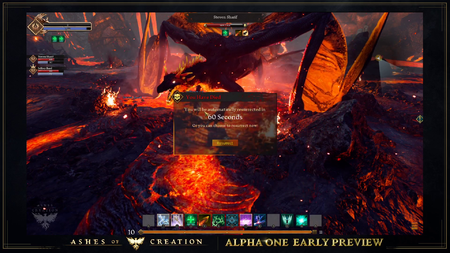
We don't have deleveling, instead what we have is experience debt. Now the more experience debt you accrue, the greater the detriment to your character; not to the point where you can not get out of the debt. There will always be a way forward to remove your debt.[49] – Steven Sharif
- Non-combatant (green players) suffer normal death penalties, which include:[6]
- Experience debt (negative experience). Experience debt scales to approximately 3 to 4 percent of the total XP for that level (subject to change based on testing).[76][77]
- Skill and stat dampening, such as Lower health and mana.[76][56][58][51][1][13]
- Reduction in loot drop rates from mobs.[78]
- Durability loss.[79][80][6]
- When players die and they take durability loss, our durability loss isn't like other games where it's a gold sink so to speak. It's a combination of both a gold sink and a material sink. So in a sense, even if you only have completed items, when you take that durability loss you are losing out on materials. It's just a debt to the materials that you are losing instead of the active loss of that material in your inventory. So now you are accruing a material debt if you want to repair and increase again the performance of those particular items that take that durability loss.[79] – Steven Sharif
- Dropping roughly 20-30% of carried gatherables, materials, and glint. The percentage values are subject to change based on Alpha-2 testing.[76][71][81][63][62][6] Glint drops as stolen glint on death.[71]
- Items made for final consumption are not dropped, such as consumable items created by the Kochen and Alchemy professions.[81]
- Combatants (purple players) suffer death penalties at half the rate of non-combatants.[6]
- Corrupt players (red players) suffer death penalties at four times the rate of non-combatants.[58][3]
- Corrupt players also have a chance to drop any equipped items based on their current corruption score, including dropping weapons and armor.[3][8][58][3][82][6]
- Any amount of corruption allows a player to drop equipped gear upon death. The higher the corruption the greater the chances.[83] – Steven Sharif
- Corrupt players respawn at random locations in the vicinity of their death, not at regular spawn points.[21] Non-corrupt players always respawn at the closest active respawn point (to their death).[84]
- Corruption penalties occur as the corruption is gained (not just at death).[5]
- Death penalties for corrupt players apply in every location, including naval PvP zones.[85]
Death penalties (mostly) do not apply to objective-based PvP (also called sanctioned events).[86][87][88][89]
- There will not be death penalties applied to event-based deaths. The penalties are in the outcome of the event. So your number of deaths is likely going to impact your ability to win that particular event and that's going to be the penalty. This is it to encourage players to opt in to the events right because the more participation we have the more fun it can be; and we understand that the community at large- there's already a risk versus reward component to these events. We don't need to stack on additional risk versus reward to inhibit kind of- to increase the barrier to entry for players who may not be as interested.[89] – Steven Sharif
- Gear degradation applies on death during Karawanen-PvP.[87][88]
- Previously it was stated that death penalties do not differ between PvP and PvE.[90]
Non-corrupt players suffer reduced death penalties in naval PvP (open seas) zones.[85]
- These penalties will be less than those for a green player.[91]
- Q: We know that the normal death penalty incurs a myriad of penalties for the player, but we don't know the numbers behind this penalty. For instance, what percentage of materials do players drop? What percentage of glint is dropped? How severe is the skill and stat dampening? What is the average time it will take a player to work off XP debt from one death?
- A: You're asking about percentile values. You're asking about time that it takes to recoup the percentage and whatnot. Any time that we're at a stage we're in now, and that in Alpha-2 we're going to be testing this, those values are the most subject to change. So to be clear, we're going to do [a] best-guess balance pass for Alpha-2 with the full expectation and understanding that the purpose is- and take into consideration player interaction with those numbers, and what feels best. So just off the bat, those values are not what we should be focusing on at this stage; but, to give you an idea where we are: First of all, when we're talking about dropping items that are in your material inventory, whether that be glint or that be other material types, we're talking roughly between anywhere from 20 to 30% of a stack is going to be lootable on a per-death basis. Now, that is a value that can change based off of the types of bags that you are using to carry those materials. In addition, there's other progression that can allow you, and some stats I believe, that can allow you to mitigate that value also. When we are talking about the percentage that's lost, or excuse me, not lost, the percentage of your level that is accrued as experience debt from death, generally you can expect that that's going to live around three to four percent of the level in accrued experience debt per death. However, additionally, there is a way to mitigate that percentage debt; and that is through the resurrection ability that's provided to Clerics. So, Clerics have the ability to resurrect their allies, and that resurrection will return a percentage that would have been accrued as experience debt. And that return percentage is predicated on the investment into the resability [sic], as well as the stat of the Cleric that is tied to the resurrection effect as well. So those can return percentages, so you can mitigate that to a degree. How long will it take you to recover that, and what stat dampening occurs? Anywhere within a level, if you acquire 100% experience debt for that level, you max out the experience debt, essentially, you don't ever buy that down, you're probably looking around a 20% stat efficacy dampener. So on average, if you're at 100% debt for a level, and you got to work all that off before you can start progressing at the level again, you're at around 20% overall stat dampening. Time it takes you to regain that debt is predicated on the level you're at and how you exp. So, that's a highly variable value.[76] – Steven Sharif
- Reduction in gear proficiency.[6]
Skill and stat dampening
Skill and stat dampening penalties are applied when a player dies or when they gain corruption. This causes negative effects, such as a reduction of health and mana.[56][58][51][1][13]
- Reaching maximum experience debt for a level can result in roughly 20% stat dampening for that character. This percentage is expected to be highly variable.[76]
- Anywhere within a level, if you acquire 100% experience debt for that level, you max out the experience debt, essentially, you don't ever buy that down, you're probably looking around a 20% stat efficacy dampener. So on average, if you're at 100% debt for a level, and you got to work all that off before you can start progressing at the level again, you're at around 20% overall stat dampening. Time it takes you to regain that debt is predicated on the level you're at and how you exp. So, that's a highly variable value.[76] – Steven Sharif
- Non-combatant players accrue skill and stat dampening on death at twice the rate of combatants.[56][58][51][1][13]
- Corrupted players gain skill and stat dampening as soon as corruption is gained. This increases each time corruption is gained until they ultimately become ineffective at PvP combat.[5][54][56][58][51][3][52][53][7][1][13][6]
Respawn locations
Non-corrupt players always respawn at the closest active respawn point (to their death).[84]
- Corrupt players respawn at random locations in the vicinity of their death, not at regular spawn points.[21]
- There will not be custom respawn points that can be placed in the world.[93]
- Events in progress may disable certain respawn points in proximity to those events, which might cause players to respawn further away.[84]
- That has to do with the lore behind death and resurrection and what it means to have your soul connected as a conduit of that spark of life given from the Goddess of Creation, being that phoenix type of avatar; and if corruption has moved into an area and an event has started, the access to those ley line oriented respawn points may be obscured- might not be accessible. So that could create some additional distance that needs to be traveled as part of these types of events.[84] – Steven Sharif
Siehe auch
Einzelnachweise
- ↑ 1.0 1.1 1.2 1.3 1.4 1.5 Podcast, 2018-04-23 (51:31).
- ↑ 2.0 2.1 2.2 2.3 2.4

- ↑ 3.0 3.1 3.2 3.3 3.4 3.5 3.6 3.7 3.8 3.9 Interview, 2020-07-18 (41:54).
- ↑ 4.0 4.1 4.2 4.3 4.4 4.5 4.6 4.7 MMOGames interview, January 2017
- ↑ 5.0 5.1 5.2 5.3
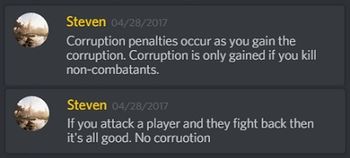
- ↑ 6.00 6.01 6.02 6.03 6.04 6.05 6.06 6.07 6.08 6.09 6.10 Podcast, 2017-05-05 (43:05).
- ↑ 7.0 7.1 7.2 Interview, 2018-05-11 (5:05).
- ↑ 8.0 8.1 Liveübertragung, 2017-11-17 (35:20).
- ↑ Interview, 2017-02-01 (39:33).
- ↑ 10.0 10.1 10.2 10.3 10.4 10.5 10.6 10.7 Interview, 2017-04-27 (0:17).
- ↑ 11.0 11.1 11.2 11.3

- ↑ 12.0 12.1 12.2 Interview, 2017-04-27 (1:18).
- ↑ 13.0 13.1 13.2 13.3 13.4 13.5 Liveübertragung, 2017-05-22 (42:33).
- ↑

- ↑ Liveübertragung, 2020-01-30 (1:40:48).
- ↑ Liveübertragung, 2018-07-09 (20:41).
- ↑ 17.0 17.1 17.2 17.3 Interview, 2020-07-18 (44:35).
- ↑
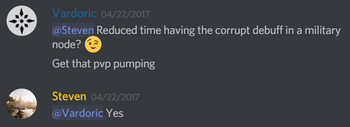
- ↑ Liveübertragung, 2020-06-26 (1:50:24).
- ↑ 20.0 20.1 20.2 20.3 20.4 20.5

- ↑ 21.0 21.1 21.2 Interview, 2017-04-27 (9:28).
- ↑ 22.0 22.1
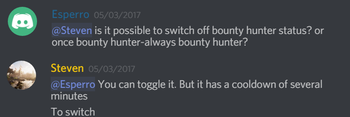
- ↑

- ↑ 24.0 24.1 Liveübertragung, 2017-05-24 (48:00).
- ↑ Liveübertragung, 2019-07-26 (1:20:48).
- ↑ Liveübertragung, 2021-06-25 (1:06:22).
- ↑ Interview, 2017-01-20 (06:12).
- ↑ The mighty beard!
- ↑ Interview, 2017-04-27 (9:28).
- ↑ Interview, 2018-10-20 (1:15:10).
- ↑

- ↑ Liveübertragung, 2020-02-28 (1:14:38).
- ↑ Liveübertragung, 2017-05-12 (24:52).
- ↑

- ↑ 35.0 35.1 35.2

- ↑

- ↑

- ↑ 38.0 38.1 Liveübertragung, 2021-07-30 (1:10:34).
- ↑ 39.0 39.1 Podcast, 2021-04-11 (34:41).
- ↑ 40.0 40.1 Liveübertragung, 2020-11-30 (1:09:06).
- ↑ Liveübertragung, 2018-10-31 (44:12).
- ↑ 42.0 42.1 Interview, 2019-04-22 (54:40).
- ↑ 43.0 43.1 Liveübertragung, 2017-11-17 (29:45).
- ↑

- ↑ 45.0 45.1 45.2

- ↑ 46.0 46.1 Interview, 2020-07-08 (1:05:27).
- ↑
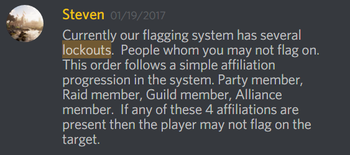
- ↑

- ↑ 49.0 49.1 Podcast, 2018-04-23 (49:21).
- ↑ 50.0 50.1 50.2 50.3 50.4
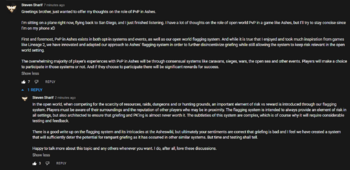
- ↑ 51.0 51.1 51.2 51.3 51.4 51.5 51.6 51.7 51.8 51.9
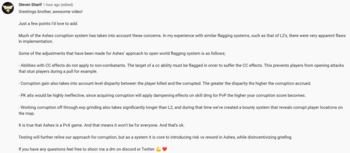
- ↑ 52.0 52.1 52.2 52.3

- ↑ 53.0 53.1 53.2 Interview, 2018-08-24 (8:35).
- ↑ 54.0 54.1 54.2

- ↑ 55.0 55.1

- ↑ 56.0 56.1 56.2 56.3 56.4 56.5 56.6 56.7 56.8 Liveübertragung, 2022-10-28 (26:48).
- ↑

- ↑ 58.0 58.1 58.2 58.3 58.4 58.5 58.6 Liveübertragung, 2022-10-28 (24:28).
- ↑ 59.0 59.1 Video, 2024-02-29 (19:35).
- ↑ Liveübertragung, 2021-09-24 (51:20).
- ↑ 61.0 61.1 61.2 Liveübertragung, 2021-03-26 (1:07:33).
- ↑ 62.0 62.1

- ↑ 63.0 63.1 Interview, 2020-07-18 (27:11).
- ↑ Podcast, 2023-07-15 (26:31).
- ↑ Liveübertragung, 2023-04-28 (1:18:48).
- ↑ Podcast, 2023-07-15 (28:28).
- ↑ 67.0 67.1 Liveübertragung, 2021-01-29 (1:24:27).
- ↑ Liveübertragung, 2018-09-27 (47:46).
- ↑
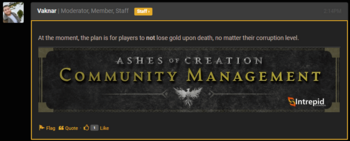
- ↑ Liveübertragung, 2023-11-30 (1:52:37).
- ↑ 71.0 71.1 71.2 Interview, 2023-09-10 (53:47).
- ↑ 72.0 72.1 Liveübertragung, 2022-02-25 (1:06:45).
- ↑ 73.0 73.1 Liveübertragung, 2022-04-29 (1:08:27).
- ↑ Liveübertragung, 2017-07-28 (50:22).
- ↑ Liveübertragung, 2020-03-28 (1:58:24).
- ↑ 76.0 76.1 76.2 76.3 76.4 76.5 Liveübertragung, 2024-03-29 (3:21).
- ↑ Liveübertragung, 2017-05-19 (13:37).
- ↑ Ashes of Creation Forums - Former Lineage 2 PvP'er wanting to discuss PvP loopholes.
- ↑ 79.0 79.1 Interview, 2021-02-07 (13:14).
- ↑ Interview, 2020-07-29 (16:46).
- ↑ 81.0 81.1 Liveübertragung, 2022-12-02 (1:26:02).
- ↑ Interview, 2018-05-11 (15:41).
- ↑

- ↑ 84.0 84.1 84.2 84.3 Liveübertragung, 2021-06-25 (1:15:37).
- ↑ 85.0 85.1 Interview, 2023-07-09 (36:56).
- ↑ Liveübertragung, 2023-02-24 (1:29:45).
- ↑ 87.0 87.1 Liveübertragung, 2022-06-30 (1:14:52).
- ↑ 88.0 88.1 Liveübertragung, 2021-08-27 (1:22:56).
- ↑ 89.0 89.1 Liveübertragung, 2020-12-22 (1:13:51).
- ↑ Liveübertragung, 2017-05-15 (36:23).
- ↑ Interview, 2023-07-09 (38:03).
- ↑ Video, 2022-12-02 (16:29).
- ↑ Liveübertragung, 2023-05-31 (1:08:39).
